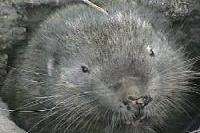Aplodontiidae
The family Aplodontiidae also known as Aplodontidae, Haplodontiidae or Haploodontini is traditionally classified as the sole extant family of the suborder Protrogomorpha. It may be the sister family of the Sciuridae.[1] There are fossils from the Oligocene until Miocene in Asia, from Oligocene in Europe and from the Oligocene until the present in North America, where there is the only living species: the mountain beaver (Aplodontia rufa).[2]
| Aplodontiidae Temporal range: Oligocene to present | |
|---|---|
 | |
| Mountain beaver (Aplodontia rufa) | |
| Scientific classification | |
| Kingdom: | Animalia |
| Phylum: | Chordata |
| Class: | Mammalia |
| Order: | Rodentia |
| Suborder: | Sciuromorpha |
| Family: | Aplodontiidae Brandt, 1855 |
| Genera | |
|
See text | |
Systematics
It includes the following genera:
- †Altasciurus Korth, 2019
- †Ameniscomys Dehm, 1950
- †Ansomys Qiu, 1987
- Aplodontia Richardson, 1829
- †Dakotallomys[3] Tedrow and Korth, 1999
- †Disallomys[4] Korth, 2009
- †Ephemeromys Wang & Heissig, 1984
- †Haplomys Miller and Gidley, 1918
- †Leptoromys[5] Tedrow and Korth, 1997
- †Liodontia Miller and Gidley, 1918
- †Meniscomys Cope, 1879
- †Niglarodon Black, 1961
- †Ninamys[2] Vianey-Liaud, Rodrigues & Marivaux, 2013
- †Oligopetes Heissig, 1979
- †Paracitellus Dehm, 1950
- †Paransomys[2] Vianey-Liaud, Rodrigues & Marivaux, 2013
- †Proansomys[6] Bi, Meng, McLean, Wu, Ni & Ye, 2013
- †Prosciurus Matthew, 1910
- †Pseudaplodon Miller, 1927
- †Sciurodon Schlosser, 1884
- †Selenomys Matthew and Granger, 1923
- †Sewelleladon Shotwell, 1958
- †Tardontia Shotwell, 1958
- †Trigonomys Heissig, 1979
gollark: But having computers predict user behaviour granularly is really hard, so the only capabilities for that are very primitive.
gollark: CPUs also have prefetching for cache.
gollark: It might stick them in swap. You'd want to use mlock or something to make a block of memory which is actually guaranteed to be in memory.
gollark: Why would it clear files in tmpfs?
gollark: And hardware encoding's only good when you don't care that much about quality or bitrate anyway.
References
- Wilson and Reeder (2005). Mammal Species of the World: A Taxonomic and Geographic Reference. 1 (3 ed.). p. 753. ISBN 9780801882210.
- Vianey-Liaud, Monique; Gomes Rodrigues, Helder; Marivaux, Laurent (2013). "Early adaptive radiations of Aplodontoidea (Rodentia, Mammalia) on the Holarctic region: systematics, and phylogenetic and paleobiogeographic implications". Paläontologische Zeitschrift. 87 (1): 83–120. doi:10.1007/s12542-012-0143-3.
- A. R. Tedrow and W. W. Korth. 1999. Paludicola 2(3):257.
- Korth, William W. (2009). "Mammals from the Blue Ash local fauna (late Oligocene), South Dakota. Rodentia, Part 4: Family Aplodontidae". Paludicola. 7 (3): 89–106.
- A. R. Tedrow and W. W. Korth. 1997. Paludicola 1(2):80-90.
- Bi, Shundong, Jin Meng, Sarah McLean, Wenyu Wu, Xijun Ni & Jie Ye. 2013. A New Genus of Aplodontid Rodent (Mammalia, Rodentia) from the Late Oligocene of Northern Junggar Basin, China. Public Library of Science, ONE 8(1): e52625.
This article is issued from Wikipedia. The text is licensed under Creative Commons - Attribution - Sharealike. Additional terms may apply for the media files.